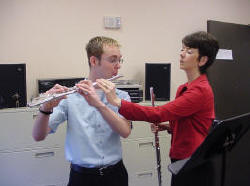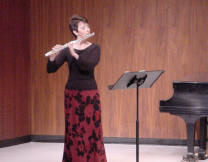|
Flute Fingering Faults by |
All too often student flutists learn basic fingerings incorrectly, and these flaws in finger technique result in poor tone, pitch inconsistencies, and uneven facility, all of which are frustrating to both teacher and student. Students should always keep an accurate fingering chart handy, and teachers should watch intently to enforce precise fingerings.
Any
discussion of finger technique rightly begins with hand position,
and the importance of the proper relationships between the flute
and the body cannot be overemphasized. The right hand should curve
naturally over the keys, with the right thumb on its side, the
pinky curved to the right, and a straight wrist. The left hand
cradles the flute at the first joint of the index finger, with
the wrist bent under the flute, the palm facing down the instrument,
and the fingers curved naturally over the keys. Cramped hands
frequently cause students to seek a fingering — any fingering — that
fits their twisted hands. ( For a more thorough discussion of hand
position, see Brian Luce’s "The Demons of Hand Position"
in Flute Talk, vol. 21, No.1.)

The range of the flute breaks easily into three octaves, beginning with the first octave, which extends from middle C to third space C. The lower register offers fewer opportunities for mistakes, but one common one is failure to depress the right hand pinky (Eb key) when playing low E. Without the pinky key depressed, the tone is fuzzy and the pitch is flat. Another common problem is F#, which should be played with the third finger of the right hand, not the second or "middle" finger. Use of "middle" F# causes the results of the previous violation; that is, the tone will be dull and the pitch flat. The only other area of concern is the use of the thumb Bb. Use of thumb Bb should be encouraged, but beginning students should also know the other fingerings that are better suited to scales in sharp keys and the chromatic.
The middle octave has fingering traps similar to the lower octave. Again, the pinky must be depressed for E natural, the third finger should be used for F#, and the three Bb fingerings should be taught. Students often finger the pitches D and Eb like their counterparts and octave lower, and these fingerings are simply wrong. The first finger of the left hand must be up for middle D and Eb. Neglecting to do so results in flat, muffled tones that do not blend well with the ensemble.
Fingerings begin changing more drastically in the third octave; thus, it is no surprise that many common fingering faults are found in the higher register. One common error is to use fingerings from the middle register and then overblow to the higher partial in the harmonic series. The consequence, however, is tones that lack clarity and are not true to pitch. Another prevalent mistake is that of keeping the thumb Bb lever on for high Gb — only the regular thumb key should be used.
Other fingering errors occur frequently at the top of the range, from high Ab to high C. The following reinforcements should be drilled into young flutists: Do not press down the left hand first finger on high Ab or Bb. Press the right hand pinky for high A natural, but do NOT press it for high Bb and B natural. If the flute has a "gizmo" (high-C facilitator) key on the B footjoint, then the gizmo must be used for high C. f there is no gizmo, then no pinky key is depressed. Students should constantly be reminded that the third octave primary fingerings, while occasionally awkward, do produce the best and most reliable sounds.
Good hand position and use of primary fingerings encourage fluid technique, tonal consistency, and true pitch relationships. Remember that there are no short cuts to reliable technical skill — just short cuts to frantic fingers and inferior tone qualities!

| If you would like to be added to the TSMP Email Mailing List and receive periodic notifications of new articles and updates to this website, then please email TSMP.
The Texas School Music
Project is a source for ideas and information
concerning pedagogical
practices in the music classroom or rehearsal hall. The TSMP is a service provided to
all music specialists by the faculty
of
the Department of Music
at Stephen F. Austin State University. Copyright ? 2002, Department of Music at Stephen F. Austin State University |
_small.jpg)